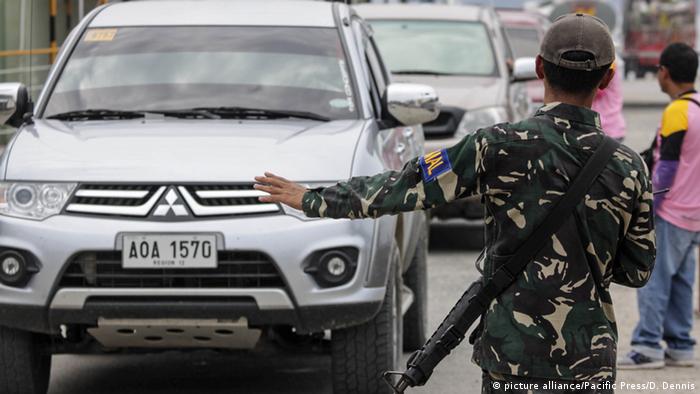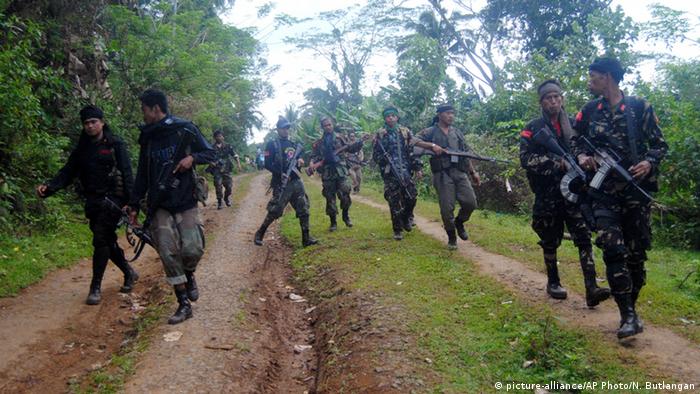Philippines
Abu Sayyaf as a copycat of the IS
The Filipino underground organization, the Abu Sayyaf seeks the propagandistic proximity to the “Islamic state”. But according to experts it has no strong ideological similarities with the IS.

The Philippine Islamists militia Abu Sayyaf killed according to information from a canadian hostage. The government in Manila has confirmed on Tuesday, the circulating media reports. The canadian Robert Hall had been kidnapped in September 2015, along with three other people, including another canadian, from a hotel on the beach in southern Mindanao. The Islamists had announced the murder of their hostages, should not be accepted by their multi-million dollar ransom demands.
Already in 2014, the Abu Sayyaf had held in the South of the Philippines, a German sailing couple as hostages. The extremists demanded four million Euro ransom and the withdrawal of Germany from the fight against the terrorist network “Islamic state” (IS). Manila sent soldiers, and search teams on the island of Jolo. 17. October 2014 finally came the German hostages. It is unclear whether their ransom was given instead of accounts receivable.

Abu Sayyaf has killed the canadian Robert Hall (l.)
Organised terrorist movement?
Abu Sayyaf, in English: “sword fighters”, is a radical Islamic terrorist organization in the Muslim South of the Philippines. Since the beginning of the 1990s, the fighters on the southern island of Mindanao were active and there for numerous kidnappings and terrorist attacks. The core of the group’s approximately 200 members, across the country, there should be a total of around 2000 supporters. The Abu Sayyaf terrorist group was gone from the “National liberation front, the Moro” (MNLF). She was a rebel group that has fought since the 1970s for an independent Islamic state in the southern Islands of the Philippines. The members of the Abu Sayyaf rejected the moderate line of the MNLF. “Since the death of their leader, Abdurajak Janjalani in 1998, the Abu Sayyaf is missing, however, is an ideological orientation,” says Joseph Franco, a security expert at the S. Rajaratnam School of International Studies (RSIS) in Singapore. The ASG is now deeply divided and more of a “collection of armed groups as an organized terrorist or secessionist movement,” says Franco. For Tony La Viña, Dean of Ateneo School of Government in Manila, Abu Sayyaf is merely “a bandit group, which is financed through criminal activities, particularly through extortionate kidnapping.”
The exclusion of a peace Pact
In March 2014, the Philippine government had signed a peace Treaty with “the Moro Islamic liberation front” (MILF), the largest Muslim rebel front in the Philippines. The MILF had spun off the end of the 1970s of the “National liberation front of the Moros” (MNLF). Other Islamist-influenced organisations, such as MILF-a splinter group of the terrorist group “Bangsamoro Islamic Freedom Fighters” (BIFF) and Abu Sayyaf were involved in the agreement in the spring. “Abu Sayyaf has no political demands, therefore the group is not part of peace negotiations,” the lawyer of La Viña.

The Philippine flag was hoisted by government soldiers in a captured Camp of the rebels
The peace agreement is considered to be the most promising to end the decades-long conflict between the government of the majority Christian country and its Muslim minority. Was provided a larger Autonomous Muslim Region in the South called Bangsamoro (“Nation of Muslims”), which is to make up around ten percent of the land area. However, the necessary fundamental law of the new Muslim state (the”Bangsamoro Basic Law has not been adopted”) by the Philippine Congress. In addition, Abu Sayyaf and other terrorist groups continue to threaten the peace process in Mindanao and on the Islands of the Sulu archipelago.
Manila relies on a military response
The Philippine government in Manila has repeatedly made it clear that no negotiations with Abu Sayyaf, and instead, a stronger military response is the preferred. The Aquino government has stepped up since the 2014 their military presence in the Region. “We don’t negotiate with terrorists”, had at that time, the Philippine defence Minister Voltaire Gazmin said. “Abu Sayyaf is only Propaganda. Our government is not responsive to the demands of these terrorists. Let such Gestures and actions not to be intimidated,” said Gazmin.
The President-elect Rodrigo Duterte threatened to Abu Sayyaf at a press conference recently with a “settlement”, should not allow the grouping of their hostages and surrender. Concrete measures to be taken against Abu Sayyaf Duterte is not called. He wanted to look after his inauguration on June 30. June to deal with it. Currently, more than 20 Locals and foreigners are still in the hands of the Abu Sayyaf.

The other rebel group “Moro National Liberation Front”
Tendency to fraternisation with IS so far low
It is known that the Abu Sayyaf has been a long and intensive contact with other Islamist terrorist organizations such as Al Qaeda. The now deceased founder of the Abu Sayyaf, Abdurajik Janjalani, the former fighters in the Afghan civil war with the Soviet Union. Many members of the Abu Sayyaf were also trained in Camps in Pakistan, Afghanistan and Saudi Arabia.
While some of the personalities of the militia have sworn, as, for example, the commander Isnilon Hapilon, IS your loyalty. Terrorism expert Franco into perspective, this gesture, however: “I see more the need of the Abu Sayyaf, to the degree of awareness of the IS-militia to continue, as a formal organisational link between the Abu Sayyaf and IS.”
Abu Sayyaf wool with their declarations of Loyalty to the IS only their threats more weight to more hijacking for a ransom. This is a view of the Philippine government represents. For a lawyer La Viña, the Abu Sayyaf continues to pose a serious threat. He doubted, however, that it comes to a shoulder-to-shoulder: “The IS will find other allies in the Philippines. I suppose that it will not be Abu Sayyaf.”